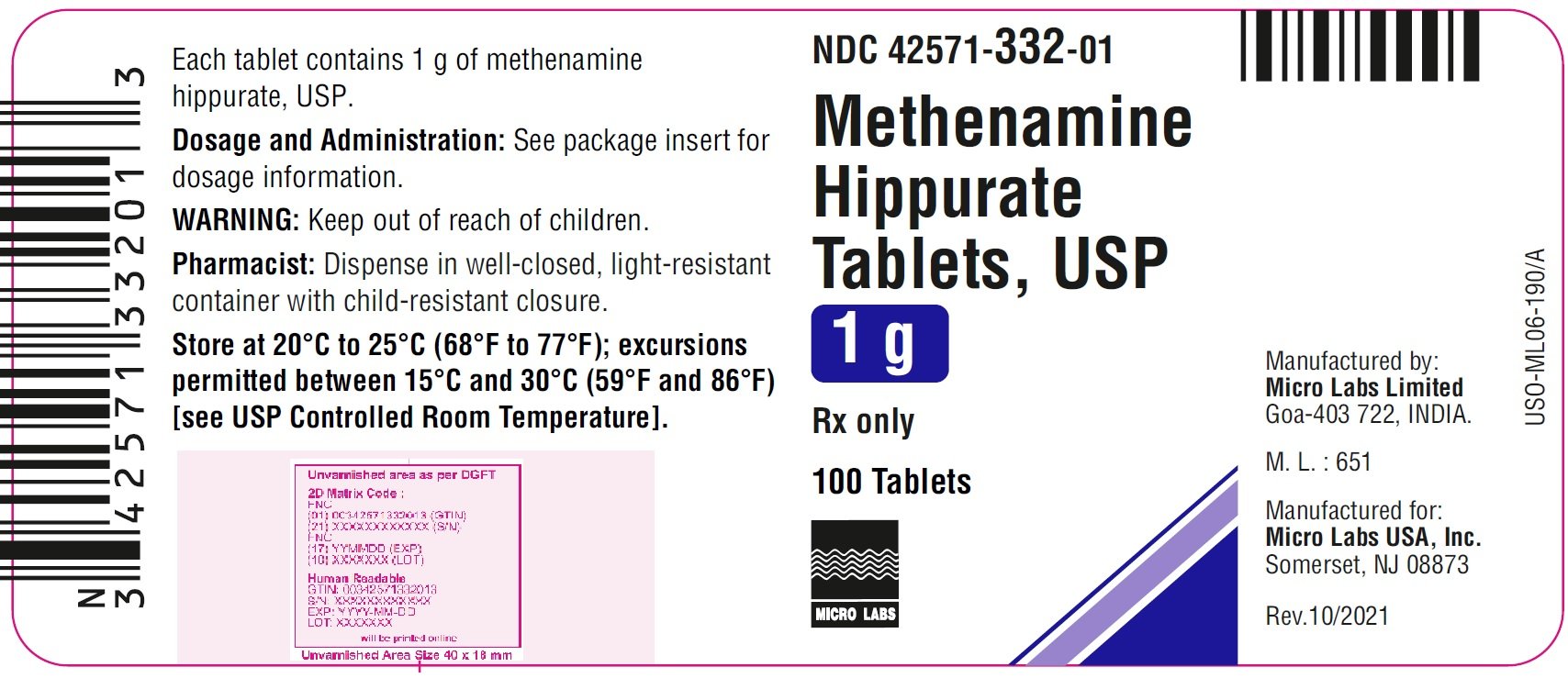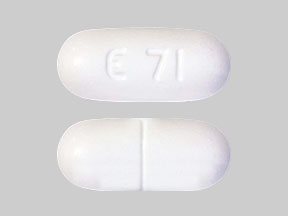Methenamine: Package Insert / Prescribing Info
Package insert / product label
Generic name: methenamine hippurate
Dosage form: tablet
Drug class: Urinary anti-infectives
Medically reviewed by Drugs.com. Last updated on May 23, 2025.
On This Page
Methenamine Description
Each white to off-white capsule-shaped tablet contains 1 g Methenamine Hippurate USP which is the Hippuric Acid Salt of Methenamine (hexamethylene tetramine). The tablet also contains inactive ingredients Colloidal silicon dioxide, magnesium stearate and povidone K90.
ACTIONS
Microbiology:Methenamine hippurate has antibacterial activity because the methenamine component is hydrolyzed to formaldehyde in acid urine. Hippuric acid, the other component, has some antibacterial activity and also acts to keep the urine acid. The drug is generally active against E. coli,enterococci and staphylococci. Enterobacter aerogenesis generally resistant. The urine must be kept sufficiently acid for urea-splitting organisms such as Proteusand Pseudomonasto be inhibited.
Susceptibility Testing
For specific information regarding susceptibility test interpretive criteria and associated test methods and quality control standards recognized by FDA for this drug, please see: https://www.fda.gov/STIC.
Human Pharmacology:Within 1/2 hour after ingestion of a single 1-gram dose of methenamine hippurate, antibacterial activity is demonstrable in the urine. Urine has continuous antibacterial activity when methenamine hippurate is administered at the recommended dosage schedule of 1 gram twice daily. Over 90% of methenamine moiety is excreted in the urine within 24 hours after administration of a single 1-gram dose. Similarly, the hippurate moiety is rapidly absorbed and excreted, and it reaches the urine by both tubular secretion and glomerular filtration. This action may be important in older patients or in those with some degree of renal impairment.
Indications and Usage for Methenamine
Methenamine hippurate tablets USP are indicated for prophylactic or suppressive treatment of frequently recurring urinary tract infections when long-term therapy is considered necessary. This drug should only be used after eradication of the infection by other appropriate antimicrobial agents.
To reduce the development of drug-resistant bacteria and maintain the effectiveness of methenamine hippurate and other antibacterial drugs, methenamine hippurate should be used only to treat or prevent infections that are proven or strongly suspected to be caused by susceptible bacteria. When culture and susceptibility information are available, they should be considered in selecting or modifying antibacterial therapy. In the absence of such data, local epidemiology and susceptibility patterns may contribute to the empiric selection of therapy.
Contraindications
Methenamine hippurate tablets USP are contraindicated in patients with renal insufficiency, severe hepatic insufficiency, or severe dehydration. Methenamine preparations should not be given to patients taking sulfonamides because some sulfonamides may form an insoluble precipitate with formaldehyde in the urine.
Warnings
Large doses of methenamine (8 grams daily for 3 to 4 weeks) have caused bladder irritation, painful and frequent micturition, albuminuria, and gross hematuria.
Precautions
Prescribing methenamine hippurate in the absence of a proven or strongly suspected bacterial infection or a prophylactic indication is unlikely to provide benefit to the patient and increases the risk of the development of drug-resistant bacteria.
- Care should be taken to maintain an acid pH of the urine, especially when treating infections due to urea-splitting organisms such as Proteusand strains of Pseudomonas.
- In a few instances in one study, the serum transaminase levels were slightly elevated during treatment but returned to normal while the patients were still taking methenamine hippurate. Because of this report, it is recommended that liver function studies be performed periodically on patients taking the drug, especially those with liver dysfunction.
- Use in Pregnancy: In early pregnancy the safe use of methenamine hippurate is not established. In the last trimester, safety is suggested, but not definitely proved. No adverse effects on the fetus were seen in studies in pregnant rats and rabbits. Methenamine hippurate taken during pregnancy can interfere with laboratory tests of urine estriol (resulting in unmeasurably low values) when acid hydrolysis is used in the laboratory procedure. This interference is due to the presence in the urine of methenamine and/or formaldehyde. Enzymatic hydrolysis, in place of acid hydrolysis, will circumvent this problem.
Geriatric Use
Clinical studies of methenamine hippurate did not include sufficient numbers of subjects aged 65 and over to determine whether they respond differently from younger subjects. Other reported clinical experience has not identified differences in responses between the elderly and younger patients. In general, dose selection for an elderly patient should be cautious, usually starting at the low end of the dosing range, reflecting the greater frequency of decreased hepatic, renal or cardiac function, and of concomitant disease or other drug therapy.
Methenamine hippurate is contraindicated in patients with renal insufficiency and severe hepatic insufficiency (s ee CONTRAINDICATIONS).
Information for Patients
Patients should be counseled that antibacterial drugs including methenamine hippurate should only be used to treat bacterial infections. They do not treat viral infections (e.g., the common cold). When methenamine hippurate is prescribed to treat a bacterial infection, patients should be told that although it is common to feel better early in the course of therapy, the medication should be taken exactly as directed. Skipping doses or not completing the full course of therapy may (1) decrease the effectiveness of the immediate treatment and (2) increase the likelihood that bacteria will develop resistance and will not be treatable by methenamine hippurate or other antibacterial drugs in the future.
Adverse Reactions/Side Effects
Minor adverse reactions have been reported in less than 3.5% of patients treated. These reactions have included nausea, upset stomach, dysuria, and rash.
To report SUSPECTED ADVERSE REACTIONS, contact Micro Labs USA Inc. at 1-855-839-8195 or FDA at 1-800-FDA-1088 or www.fda.gov/medwatch.
Related/similar drugs
Bactrim
Bactrim (sulfamethoxazole and trimethoprim) is an antibiotic used to treat ear infections, urinary ...
Macrobid
Macrobid (nitrofurantoin) is an antibiotic used to treat urinary tract infections. Includes side ...
Ozempic
Learn about Ozempic (semaglutide) for type 2 diabetes treatment, weight management, cardiovascular ...
Hiprex
Hiprex is used for bladder infection, kidney infections, prevention of bladder infection, urinary ...
Macrodantin
Macrodantin is used for bladder infection, prevention of bladder infection, urinary tract infection
SMZ-TMP DS
SMZ-TMP DS (sulfamethoxazole and trimethoprim) is an antibiotic used to treat ear infections ...
Co-trimoxazole
Co-trimoxazole is used for bacterial infection, bacterial skin infection, bronchitis ...
Septra
Septra is an antibiotic containing sulfamethoxazole and trimethoprim used to treat ear infections ...
Trimethoprim
Trimethoprim is used for bladder infection, middle ear infections, pneumocystis pneumonia ...
Sulfamethoxazole/trimethoprim
Sulfamethoxazole/trimethoprim is used for acne, bacterial infection, bacterial skin infection ...
Methenamine Dosage and Administration
1 tablet (1 g) twice daily (morning and night) for adults and pediatric patients over 12 years of age. 1/2 to 1 tablet (0.5 to 1 g) twice daily (morning and night) for pediatric patients 6 to 12 years of age. Since the antibacterial activity of methenamine hippurate is greater in acid urine, restriction of alkalinizing foods and medications is desirable. If necessary, as indicated by urinary pH and clinical response, supplemental acidification of the urine should be instituted. The efficacy of therapy should be monitored by repeated urine cultures.
How is Methenamine supplied
White to off white colored, capsule shaped, biconvex tablets, debossed with "H" and "1" on either side of breakline on one side and other side plain with approximate length 20.00 mm, width 8.00 mm and thickness 7.40 mm.
Bottles of 100 NDC 42571-332-01
Carton of 80 (8 x10) Unit-dose Tablets NDC 42571-332-23
Store at 20°C to 25°C (68°F to 77°F); excursions permitted between 15°C and 30°C (59°F and 86°F) [see USP Controlled Room Temperature].
Dispense in well-closed, light-resistant container with child-resistant closure.
Manufactured by:
Micro Labs Limited
Goa-403 722, INDIA.
Manufactured for:
Micro Labs USA, Inc.
Somerset, NJ 08873
Rev.10/2021
| METHENAMINE HIPPURATE
methenamine hippurate tablet |
||||||||||||||||||||
|
||||||||||||||||||||
|
||||||||||||||||||||
|
||||||||||||||||||||
|
||||||||||||||||||||
|
||||||||||||||||||||
|
||||||||||||||||||||
| Labeler - Micro Labs Limited (862174955) |
| Establishment | |||
| Name | Address | ID/FEI | Business Operations |
|---|---|---|---|
| Micro Labs Limited | 915793658 | analysis(42571-332) , label(42571-332) , manufacture(42571-332) , pack(42571-332) | |
More about methenamine
- Check interactions
- Compare alternatives
- Pricing & coupons
- Reviews (105)
- Drug images
- Side effects
- Dosage information
- During pregnancy
- Drug class: urinary anti-infectives
- Breastfeeding
- En español


